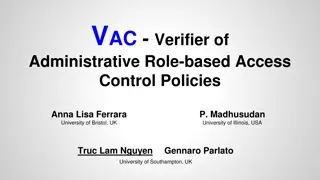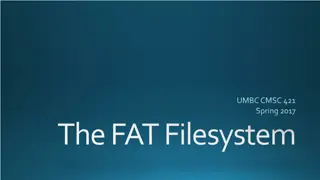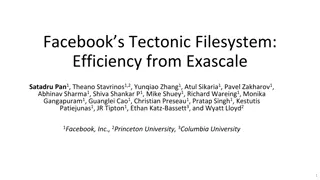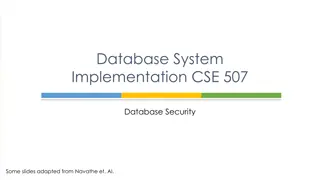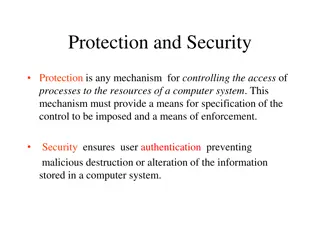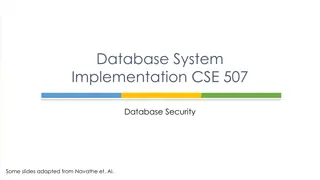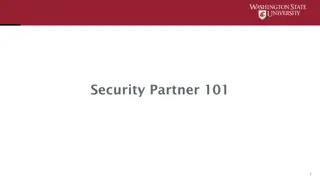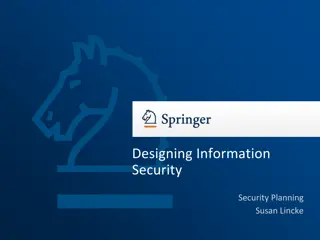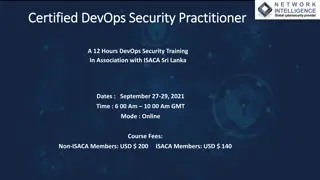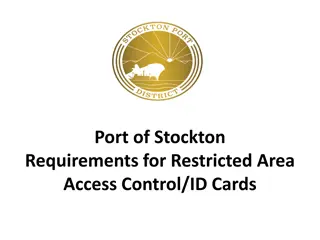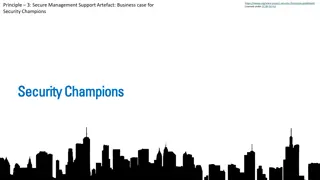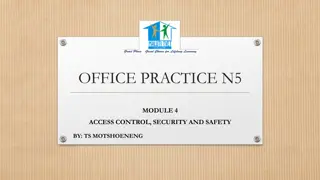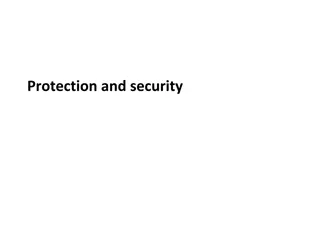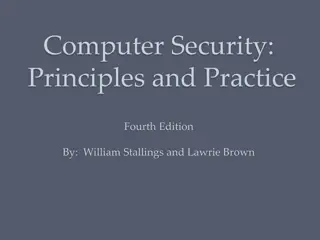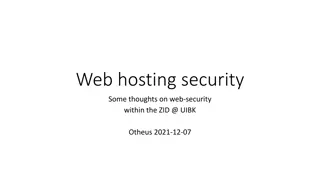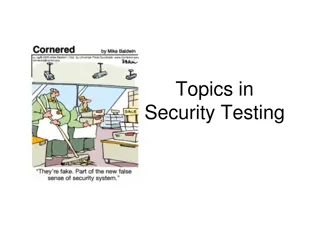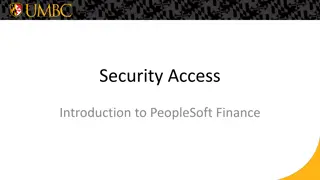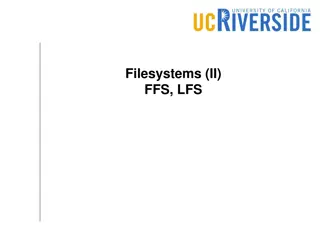Understanding Filesystem Security Principles and Access Control
Learn about filesystem security, general principles, discretionary access control (DAC), closed vs. open policy, closed policy with negative authorizations, and access control entries and lists. Discover how files and folders are managed, the role of access control lists (ACLs), and the different levels of security provided by various access control models in operating systems.
Download Presentation

Please find below an Image/Link to download the presentation.
The content on the website is provided AS IS for your information and personal use only. It may not be sold, licensed, or shared on other websites without obtaining consent from the author. Download presentation by click this link. If you encounter any issues during the download, it is possible that the publisher has removed the file from their server.
E N D
Presentation Transcript
General Principles Files and folders are managed by the operating system Applications, including shells, access files through an API Access control entry (ACE) Allow/deny a certain type of access to a file/folder by user/group Access control list (ACL) Collection of ACEs for a file/folder A file handle provides an opaque identifier for a file/folder File operations Open file: returns file handle Read/write/execute file Close file: invalidates file handle Hierarchical file organization Tree (Windows) DAG (Linux) 2
Discretionary Access Control (DAC) Users can protect what they own The owner may grant access to others The owner may define the type of access (read/write/execute) given to others DAC is the standard model used in operating systems Mandatory Access Control (MAC) Alternative model not covered in this lecture Multiple levels of security for users and documents Read down and write up principles 3
Closed vs. Open Policy Closed policy Open Policy Also called default secure Deny Tom read access to foo Give Tom read access to foo Deny Bob r/w access to bar Give Bob r/w access to bar Tom: I would like to read foo Access denied Tom: I would like to read foo Access allowed Tom: I would like to read bar Access allowed Tom: I would like to read bar Access denied 4
Closed Policy with Negative Authorizations and Deny Priority Give Tom r/w access to bar Deny Tom write access to bar Tom: I would like to read bar Access allowed Tom: I would like to write bar Access denied Policy is used by Windows to manage access control to the file system 5
Access Control Entries and Lists An Access Control List (ACL) for a resource (e.g., a file or folder) is a sorted list of zero or more Access Control Entries (ACEs) An ACE refers specifies that a certain set of accesses (e.g., read, execute and write) to the resources is allowed or denied for a user or group Examples of ACEs for folder Bob s CS167 Grades Bob; Read; Allow TAs; Read; Allow TWD; Read, Write; Allow Bob; Write; Deny TAs; Write; Allow 6
Linux vs. Windows Linux Allow-only ACEs Access to file depends on ACL of file and of all its ancestor folders Start at root of file system Traverse path of folders Each folder must have execute (cd) permission Different paths to same file not equivalent File s ACL must allow requested access Windows Allow and deny ACEs By default, deny ACEs precede allow ones Access to file depends only on file s ACL ACLs of ancestors ignored when access is requested Permissions set on a folder usually propagated to descendants (inheritance) System keeps track of inherited ACE s 7
Linux File Access Control File Access Control for: Files Directories Therefore \dev\ : devices \mnt\ : mounted file systems What else? Sockets, pipes, symbolic links 8
Linux File System Tree of directories (folders) Each directory has links to zero or more files or directories Hard link From a directory to a file The same file can have hard links from multiple directories, each with its own filename, but all sharing owner, group, and permissions File deleted when no more hard links to it Symbolic link (symlink) From a directory to a target file or directory Stores path to target, which is traversed for each access The same file or directory can have multiple symlinks to it Removal of symlink does not affect target Removal of target invalidates (but not removes) symlinks to it Analogue of Windows shortcut or Mac OS alias 9
Unix Permissions Standard for all UNIXes Every file is owned by a user and has an associated group Permissions often displayed in compact 10-character notation To see permissions, use ls l jk@sphere:~/test$ ls l total 0 -rw-r----- 1 jk ugrad 0 2005-10-13 07:18 file1 -rwxrwxrwx 1 jk ugrad 0 2005-10-13 07:18 file2 10
Permissions Examples (Regular Files) -rw-r r-- read/write for owner, read-only for everyone else -rw-r----- read/write for owner, read-only for group, forbidden to others -rwx------ read/write/execute for owner, forbidden to everyone else -r--r--r-- read-only to everyone, including owner -rwxrwxrwx read/write/execute to everyone 11
Permissions for Directories Permissions bits interpreted differently for directories Read bit allows listing names of files in directory, but not their properties like size and permissions Write bit allows creating and deleting files within the directory Execute bit allows entering the directory and getting properties of files in the directory Lines for directories in ls l output begin with d, as below: jk@sphere:~/test$ ls l Total 4 drwxr-xr-x 2 jk ugrad 4096 2005-10-13 07:37 dir1 -rw-r--r-- 1 jk ugrad 0 2005-10-13 07:18 file1 12
Permissions Examples (Directories) drwxr-xr-x all can enter and list the directory, only owner can add/delete files drwxrwx--- full access to owner and group, forbidden to others drwx--x--- full access to owner, group can access known filenames in directory, forbidden to others -rwxrwxrwx full access to everyone 13
File Sharing Challenge Creating and modifying groups requires root Given a directory with permissions drwx------x and a file in it Give permission to write the file to user1, user2, user3, without creating a new group Selectively revoke a user Solution 1 Give file write permission for everyone Create different random hard links: user1-23421, user2-56784, Problem! Selectively removing access: hard link can be copied Solution 2 Create random symbolic links Problem! Symbolic link tells where it points 14
Working Graphically with Permissions Several Linux GUIs exist for displaying and changing permissions In KDE s file manager Konqueror, right-click on a file and choose Properties, and click on the Permissions tab: Changes can be made here (more about changes later) 15
Special Permission Bits Three other permission bits exist Set-user-ID ( suid or setuid ) bit Set-group-ID ( sgid or setgid ) bit Sticky bit 16
Set-user-ID Set-user-ID ( suid or setuid ) bit On executable files, causes the program to run as file owner regardless of who runs it Ignored for everything else In 10-character display, replaces the 4th character (x or -) with s (or S if not also executable) -rwsr-xr-x: setuid, executable by all -rwxr-xr-x: executable by all, but not setuid -rwSr--r--: setuid, but not executable - not useful 17
Set-group-ID Set-group-ID ( sgid or setgid ) bit On executable files, causes the program to run with the file s group, regardless of whether the user who runs it is in that group On directories, causes files created within the directory to have the same group as the directory, useful for directories shared by multiple users with different default groups Ignored for everything else In 10-character display, replaces 7th character (x or -) with s (or S if not also executable) -rwxr-sr-x: setgid file, executable by all drwxrwsr-x: setgid directory; files within will have group of directory -rw-r-Sr--: setgid file, but not executable - not useful 18
Sticky Bit On directories, prevents users from deleting or renaming files they do not own Ignored for everything else In 10-character display, replaces 10th character (x or -) with t (or T if not also executable) drwxrwxrwt: sticky bit set, full access for everyone drwxrwx--T: sticky bit set, full access by user/group drwxr--r-T: sticky, full owner access, others can read (useless) 19
Working Graphically with Special Bits Special permission bits can also be displayed and changed through a GUI In Konqueror s Permissions window, click Advanced Permissions: Changes can be made here (more about changes later) 20
Root root account is a super-user account, like Administrator on Windows Multiple roots possible File permissions do not restrict root This is dangerous, but necessary, and OK with good practices 21
Becoming Root su Changes home directory, PATH, and shell to that of root, but doesn t touch most of environment and doesn t run login scripts su - Logs in as root just as if root had done so normally sudo <command> Run just one command as root su [-] <user> Become another non-root user Root does not require to enter password 22
Changing Permissions Permissions are changed with chmod or through a GUI like Konqueror Only the file owner or root can change permissions If a user owns a file, the user can use chgrp to set its group to any group of which the user is a member root can change file ownership with chown (and can optionally change group in the same command) chown, chmod, and chgrp can take the -R option to recur through subdirectories 23
Examples of Changing Permissions chown -R root dir1 Changes ownership of dir1 and everything within it to root chmod g+w,o-rwx file1 file2 Adds group write permission to file1 and file2, denying all access to others Adds group read/write permission to dir1 and everything within it, and group execute permission on files or directories where someone has execute permission chmod -R g=rwX dir1 chgrp testgrp file1 Sets file1 s group to testgrp, if the user is a member of that group chmod u+s file1 Sets the setuid bit on file1. (Doesn t change execute bit.) 24
Octal Notation Previous slide s syntax is nice for simple cases, but bad for complex changes Alternative is octal notation, i.e., three or four digits from 0 to 7 Digits from left (most significant) to right(least significant): [special bits][user bits][group bits][other bits] Special bit digit = (4 if setuid) + (2 if setgid) + (1 if sticky) All other digits = (4 if readable) + (2 if writable) + (1 if executable) 25
Octal Notation Examples 644 or 0644 read/write for owner, read-only for everyone else 775 or 0775 read/write/execute for owner and group, read/execute for others 640 or 0640 read/write for owner, read-only for group, forbidden to others 2775 same as 775, plus setgid (useful for directories) 777 or 0777 read/write/execute to everyone (dangerous!) same as 777, plus sticky bit 1777 26
Limitations of Unix Permissions Unix permissions are not perfect Groups are restrictive Limitations on file creation Linux optionally uses POSIX ACLs Builds on top of traditional Unix permissions Several users and groups can be named in ACLs, each with different permissions Allows for finer-grained access control Each ACL is of the form type:[name]:rwx Setuid, setgid, and sticky bits are outside the ACL system 27
Minimal ACLs In a file with minimal ACLs, name does not appear, and the ACLs with type user and group correspond to Unix user and group permissions, respectively. When name is omitted from a user type ACL entry, it applies to the file owner. user : : r w group : : r other : : 28
ACL Commands ACLs are read with the getfacl command and set with the setfacl command. Changing the ACLs corresponding to Unix permissions shows up in ls -l output, and changing the Unix permissions with chmod changes those ACLs. Example of getfacl: jimmy@techhouse:~/test$ ls -l total 4 drwxr-x--- 2 jimmy jimmy 4096 2005-12-02 04:13 dir jimmy@techhouse:~/test$ getfacl dir # file: dir # owner: jimmy # group: jimmy user::rwx group::r-x other::--- 29
More ACL Command Examples jimmy@techhouse:~/test$ setfacl -m group::rwx dir jimmy@techhouse:~/test$ ls -l total 4 drwxrwx--- 2 jimmy jimmy 4096 2005-12-02 04:13 dir jimmy@techhouse:~/test$ chmod 755 dir jimmy@techhouse:~/test$ getfacl dir # file: dir # owner: jimmy # group: jimmy user::rwx group::r-x other::r-x 30
Extended ACLs ACLs that say more than Unix permissions are extended ACLs Specific users and groups can be named and given permissions via ACLs, which fall under the group class (even for for ACLs naming users and not groups) With extended ACLs, mapping to and from Unix permissions is a bit complicated. User and other classes map directly to the corresponding Unix permission bits Group class contains named users and groups as well as owning group permissions. How to map? 31
Mask-type ACLs user : : r w user : joe : r w group : : r mask: : r w other : : 32
Mask-type ACLs Unix group permissions now map to an ACL of type mask , which is an upper bound on permissions for all group class ACLs. All group class ACLs are logically and-ed with the mask before taking effect rw- xrw- & r-x x--- = r----x-- The ACL of type group with no name still refers to the Unix owning group Mask ACLs are created automatically with the necessary bits such that they do not restrict the other ACLs at all, but this can be changed 33
Extended ACL Example jimmy@techhouse:~/test$ ls -l total 4 drwxr-xr-x 2 jimmy jimmy 4096 2005-12-02 04:13 dir jimmy@techhouse:~/test$ setfacl -m user:joe:rwx dir jimmy@techhouse:~/test$ getfacl dir # file: dir # owner: jimmy # group: jimmy user::rwx user:joe:rwx group::r-x mask::rwx other::r-x jimmy@techhouse:~/test$ ls -l total 8 drwxrwxr-x+ 2 jimmy jimmy 4096 2005-12-02 04:13 dir 34
Extended ACL Example Explained The preceding slide grants the named user joe read, write, and execute access to dir. dir now has extended rather than minimal ACLs. The mask is set to rwx, the union of the two group class ACLs (named user joe and the owning group). In ls -l output, the group permission bits show the mask, not the owning group ACL Effective owning group permissions are the logical and of the owning group ACL and the mask, which still equals r-x. This could reduce the effective owning group permissions if the mask is changed to be more restrictive. The + in the ls -l output after the permission bits indicates that there are extended ACLs, which can be viewed with getfacl. 35
Default ACLs The kind of ACLs we've mentioned so far are access ACLs. A directory can have an additional set of ACLs, called default ACLs, which are inherited by files and subdirectories created within that directory. Subdirectories inherit the parent directory's default ACLs as both their default and their access ACLs. Files inherit the parent directory's default ACLs only as their access ACLs, since they have no default ACLs. The inherited permissions for the user, group, and other classes are logically and-ed with the traditional Unix permissions specified to the file creation procedure. 36
Default ACL Example jimmy@techhouse:~/test$ setfacl -d -m group:webmaster:rwx dir jimmy@techhouse:~/test$ getfacl dir # file: dir # owner: jimmy # group: jimmy user::rwx user:joe:rwx group::r-x mask::rwx other::r-x default:user::rwx default:group::r-x default:group:webmaster:rwx default:mask::rwx default:other::r-x Note how this starts the default ACLs out as equal to the existing access ACLs plus the specified changes. 37
Default ACL Example Continued jimmy@techhouse:~/test$ mkdir dir/subdir jimmy@techhouse:~/test$ getfacl dir/subdir # file: dir/subdir # owner: jimmy # group: jimmy user::rwx group::r-x group:webmaster:rwx mask::rwx other::r-x default:user::rwx default:group::r-x default:group:webmaster:rwx default:mask::rwx default:other::r-x The default ACLs from the parent directory are both the access and default ACLs for this directory. Group webmaster has full access. 38
Default ACL Example Continued jimmy@techhouse:~/test$ touch dir/file jimmy@techhouse:~/test$ ls -l dir/file -rw-rw-r--+ 1 jimmy jimmy 0 2005-12-02 11:36 dir/file jimmy@techhouse:~/test$ getfacl dir/file # file: dir/file # owner: jimmy # group: jimmy user::rw- group::r-x #effective:r-- group:webmaster:rwx #effective:rw- mask::rw- other::r-- The default ACLs from the parent directory are the basis for the access ACLs on this file, but since touch creates files without any execute bit set, the user and other classes, and the group class as well via the mask ACL, have their execute bits removed to match. 39
NTFS Permissions ACL NTFS Partition Read User 1 Read ACE User 1 Group 1 Full Control ACE User 2 Full Control Group 1 40
Basic NTFS Permissions NTFS Permission Folders Files Read Open files and subfolders Open files List Folder Contents List contents of folder, traverse folder to open subfolders Not applicable Read and Execute Not applicable Open files, execute programs Write Create subfolders and add files Modify files All the above + delete All the above Modify Full Control All the above + change permissions and take ownership, delete subfolders All the above + change permissions and take ownership 41
Multiple NTFS permissions NTFS permissions are cumulative File permissions override folder permissions Deny overrides Allow User 1 Read Group B Read/Write Folder A Group B Write User 1 File1 File2 Group A Group A Write denied 42
NTFS: permission inheritance Permission Inheritance Read/Write Folder A Access allowed for File 1 File1 Block of Inheritance Folder A Read/Write Access denied for File 1 File1 43
NTFS File Permissions Explicit: set by the owner for each user/group. Inherited: dynamically inherited from the explicit permissions of ancestor folders. Effective: obtained by combining the explicit and inherited permission. inherited effective Determining effective permissions: Rules By default, a user/group has no privileges. explicit Explicit permissions override conflicting inherited permissions. Denied permissions override conflicting allowed permissions. 44
Access Control Algorithm The DACL of a file or folder is a sorted list of ACEs Local ACEs precede inherited ACEs ACEs inherited from folder F precede those inherited from parent of F Among those with same source, Deny ACEs precede Allow ACEs Algorithm for granting access request (e.g., read and execute): ACEs in the DACL are examined in order Does the ACE refer to the user or a group containing the user? If so, do any of the accesses in the ACE match those of the request? If so, what type of ACE is it? Deny: return ACCESS_DENIED Allow: grant the specified accesses and if there are no remaining accesses to grant, return ACCESS_ALLOWED If we reach the end of the DACL and there are remaining requested accesses that have not been granted yet, return ACCESS_DENIED 45
Example Customers Group Write Folder1 NTFS Marketing Group Read Folder1 Folder1 Customers Group Customers Group Read Folder1 File1 Marketing Group Write Folder2 User1 Folder2 Customers Group Modify Folder1 File2 should only be accessible to Marketing Group, and only for read access File2 Marketing Group 46
NTFS move vs. copy in same volume Move Copy NTFS E:\ If you move a file or a folder inside the same volume your permission will be the same of the source folder If you copy a file or a folder inside the same volume your permission will be the same of the destination folder 47
NTFS move vs. copy across volumes NTFS C:\ NTFS E:\ Copy Move NTFS D:\ If you copy or move a file or a folder on different volumes your permission will be the same of the destination folder 48
Setting File Permissions in Win XP NTFS permissions in Windows XP Pro are disabled by default. Using Folder Options from Tools menu inside Windows Explorer is possible to activate NTFS permission in windows by unchecking Use simple file sharing 49
Windows Tools Access control management tools provide detailed information and controls, across multiple dialogs. Focus on single file/folders. It is challenging for an inexperienced user, or a system administrator dealing with very large file structures, to gain a global view of permissions within the file system 50



